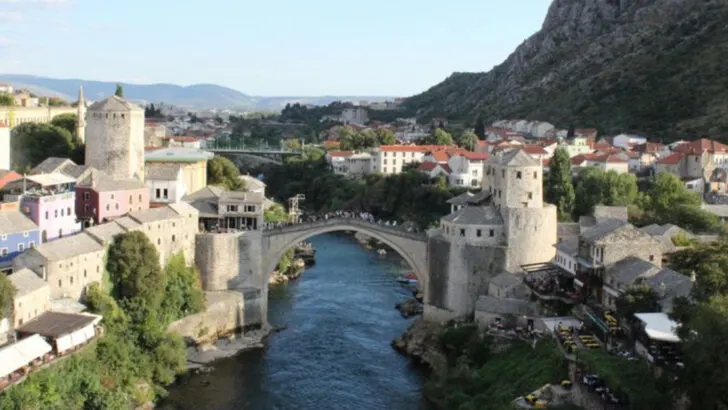Europe is home to some of the world’s most amazing bridges, each offering a unique blend of historical significance and architectural beauty.
These bridges span rivers, gorges, and even countries, connecting not just places but also people and cultures.
From medieval marvels to modern masterpieces, these structures stand as testaments to human ingenuity and creativity.
Charles Bridge
Imagine walking through history on the Charles Bridge, where each stone whispers tales of a bygone era. Built in the 14th century, this Gothic masterpiece in Prague is adorned with baroque statues that stand like silent guardians.
The bridge spans the Vltava River, connecting the Old Town with the Lesser Quarter. Many find a sunrise or sunset stroll here to be magical, as the city awakens or retreats under a golden glow.
It’s more than just a bridge; it’s a symbol of Czech heritage, where past and present seamlessly meet.
Tower Bridge
A marvel of Victorian engineering, Tower Bridge stands proudly over the Thames, its dual towers a familiar symbol of London. Completed in 1894, this bascule bridge combines Gothic architecture with innovative design, allowing it to gracefully open for passing ships.
Gazing at its reflection in the water, one can’t help but imagine the bustling city life that has passed beneath its arches.
Whether viewed in the shimmer of daylight or illuminated against a night sky, Tower Bridge remains an enduring emblem of the city’s spirit.
Ponte Vecchio
Nestled in the heart of Florence, Ponte Vecchio beckons with a blend of charm and history. This medieval bridge, known for the shops that line its span, has become a symbol of the city’s vibrant past.
Originally built in Roman times, it was reconstructed in the 14th century. As the sun sets behind the Tuscan hills, the bridge transforms into a picturesque canvas of colors.
Ponte Vecchio’s enduring allure lies in its ability to capture the essence of Florence, where commerce and culture have danced for centuries.
Millau Viaduct
Soaring above the clouds, the Millau Viaduct is a testament to modern engineering brilliance. Completed in 2004, this cable-stayed bridge is the tallest in the world, gracefully spanning the Tarn Valley in southern France.
Its sleek lines and towering pylons harmonize with the landscape, creating a breathtaking spectacle for those who cross it.
The bridge’s elegance and innovation rival the grandeur of the natural surroundings, making it not just a crossing, but a journey in itself.
Stari Most
In the heart of Mostar, Stari Most arches gracefully over the Neretva River. Originally constructed in the 16th century by the Ottomans, this bridge was a victim of war, only to be lovingly reconstructed in 2004.
Now, it stands as a powerful symbol of unity and healing in post-conflict Bosnia. The elegant curve of Stari Most is mirrored in the tranquil waters below, inviting visitors to reflect on its turbulent history and the resilience of the human spirit.
Puente Nuevo
Perched dramatically above the El Tajo gorge, Puente Nuevo is more than just a bridge; it’s a connection between two eras of Ronda. Completed in the 18th century, this stone structure links the city’s old and new towns, offering spectacular views.
The sheer cliffs and cascading river below create a scene of awe-inspiring beauty. As one strolls across, the whispers of history and the breathtaking panorama intertwine, making it an unforgettable experience in Andalusia.
Chain Bridge
Chain Bridge, a symbol of unity, gracefully links Buda and Pest across the Danube. Built in 1849, it was the first permanent bridge to connect the two halves of Budapest, forging them into one city.
At night, the bridge comes alive with lights, casting a shimmering path over the river. It’s a sight that captures the essence of Budapest’s rich history and vibrant culture, reflecting the heartbeat of a city that has embraced change while cherishing its past.
Ponte 25 de Abril
Echoing the grandeur of San Francisco’s Golden Gate, Ponte 25 de Abril spans the Tagus River with elegance. Completed in 1966, this suspension bridge is a symbol of Portugal’s leap into modernity.
Its red hue stands out against Lisbon’s skyline, offering stunning views of the city and the river. As cars and trains traverse its length, the bridge underscores the seamless blend of functionality and beauty, embodying Lisbon’s progressive spirit.
Kapellbrücke
Stepping onto Kapellbrücke is like entering a storybook. This wooden covered bridge, dating back to the 14th century, is one of Europe’s oldest. Its charming tower and 17th-century paintings tell tales of Lucerne’s past.
The bridge’s reflection in the Reuss River creates a picturesque scene that captivates tourists and locals alike.
Kapellbrücke isn’t just a passageway; it’s a cherished symbol of Lucerne’s heritage and the timeless beauty of Swiss craftsmanship.
Øresund Bridge
Stretching nearly 8 km over the Øresund Strait, this bridge is a marvel of Scandinavian design. Connecting Copenhagen and Malmö, the Øresund Bridge is both a motorway and railway, showcasing modern engineering’s finest.
Its sleek silhouette against the horizon represents the seamless blend of functionality and aesthetics. As travelers journey across, they are greeted with sweeping views of the strait, a testament to the unity and innovation that define the Nordic spirit.

